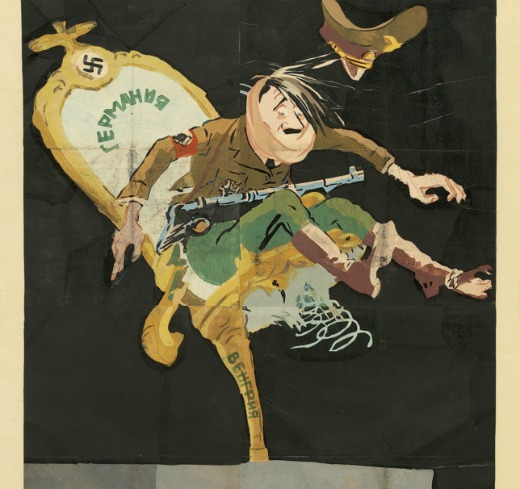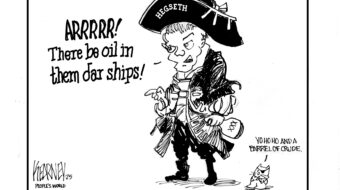
As Americans debated whether to fight Nazi Germany or not, the Soviet Union had already made its decision. Nazi Germany invaded the Union of Soviet Socialist Republics on June 22, 1941. Adolph Hitler’s invasion of the USSR broke the tenuous non-aggression pact between the two countries, and the Soviets joined the Allied effort six months before the United States was forced to do the same after Japan’s attack on Pearl Harbor.
In the wake of the Nazi invasion, Soviet artists immediately took up their paint brushes and pencils to mobilize the public to fight for the “Motherland,” and “save humanity.” This collective of writers and artists, working for the Soviet Union’s news agency TASS, created more than 1,200 storefront window-sized posters, nearly one for every day of the war.
It is some 250 of these posters that make up the new blockbuster art exhibit “Windows on the War: Soviet TASS Posters at Home and Abroad, 1941-1945” at The Art Institute of Chicago. The exhibit runs through Oct. 23.
The monumental work of these artists is almost as big and exhaustive as the contribution of the Red Army, partisans and Soviet citizens to the defeat of the Nazis. An estimated 26.5 million Soviet citizens and soldiers died in the war! The Nazis invaded and occupied a geographic equivalent of most of the western United States from the Rockies to California, into Canada and south to Arizona. Many say the USSR’s contribution was instrumental in winning the war. (Review continues after slideshow.)
The exhibit lifts the great veil of ignorance surrounding the facts about World War II. In particular that the Soviet Union partnered with England, the United States, and later France, known as the Allies, to defeat Nazi Germany and its partners, Italy and Japan, known as the Axis.
For most Americans, the war in Europe focuses on D-Day and the invasion of Normandy. Yet, the most devastating fighting took place on Germany’s dreaded “Eastern Front” where the Soviet Red Army and numerous partisan brigades fought Hitler’s troops, tank divisions and Luftwaffe, Germany’s air force.
This was a time when Joseph Stalin, Franklin Delano Roosevelt and Winston Churchill joined forces in common cause, along with the citizens of those nations and freedom-loving people around the world.
For ordinary Americans, who have learned only Cold War anti-communism and Stalin’s crimes, this fact of history is almost unimaginable. Yet, the truth cannot always be suppressed. This is definitely an exhibit Michelle Bachmann would hate.
How the Art Institute came to put on the show is almost as interesting as the posters and other artifacts on display.
In 1997, 26 tightly wrapped brown paper parcels were discovered deep in a storage area for the Department of Prints and Drawings. “Their presence was a mystery, their contents a puzzle. As conservators and curators carefully worked to open the envelopes, they were surprised and intrigued to find that they contained 50-year-old monumental posters created by artists in the Soviet Union. The idea for a major exhibition began to take shape,” says the museum press release.
The Tass posters were sent out to cultural institutions in Allied countries to build support for the Soviet war effort and cultural diplomacy. One of the recipients was the Art Institute. Apparently most of the posters were stashed away in a closet, until their discovery 13 years ago. This is the first time they can be viewed since the war.
For the show, the Art Institute added to its own posters with rare collections from around the world, especially from the Prague-based Ne boltai! Collection .
* USSR-USA relations, including Americans’ Russian War Relief effort
* art as a weapon and use of satire
* creating bi-lingual posters in and for other Soviet Republics
* Soviet liberation of concentration camps
* the battle of Stalingrad
Interestingly, yet not a total surprise, the panel that introduces the changing and complicated relations between the USSR and the U.S. is topped by a partial front page from this website’s predecessor, the Daily Worker newspaper. The headline above the Daily Worker masthead reads: “US, Britain pledge full aid to USSR; Stalin thanks 3-power parley chiefs.” Just to the side of the panel is a Soviet poster calling for the freedom of the Scottsboro prisoners.
The artists and writers work is stunning in its style, subject, mission and immensity. They created the posters using stencils and adding color in a multi-step process. Recreation of posters, plus news reels of the Tass artists are also on display.
After leaving the exhibit, emotionally and mentally exhausted, a room with a blackboard full of visitor comments sums up what most must feel:
“Thanks! Sheds light on an unknown war that saved humanity”
“Awesome”
“Chilling”
“Inspiring”
“I never knew these posters were made.”
“Let there be peace on earth.”
“Extraordinary”
“That was a very cool exhibit.”
To view posters online go to, Windows on the War on Tumblr or the museum’s website.
The exhibit is free with paid admission to the museum. Museum hours are:
Monday-Wednesday, 10:30-5:00
Thursday, 10:30-8:00
Friday-Sunday, 10:30-5:00
The Art Institute of Chicago is free to Illinois residents on the first and second Wednesdays of every month. And for Chicago Public Library card holders, a museum pass for up to four free admissions are available at local libraries.
Photo: A portion of the poster The Last Satellite by Petr Ashotovich Sarkisian, Russian, 1922-1970, October 5, 1944 shown here was a gift of the USSR Society for Cultural Relations with Foreign Countries to the Art Institute of Chicago. It depicts the fall of pro-fascist governments as the Red Army marched to Berlin and the Allies turned the tide of the war. (Courtesy of the Art Institute of Chicago)










